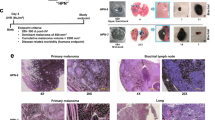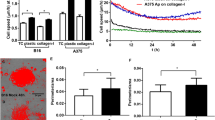Abstract
Metastatic melanoma remains a devastating disease with a 5-year survival rate of less than five percent. Despite recent advances in targeted therapies for melanoma, only a small percentage of melanoma patients experience durable remissions. Therefore, it is critical to identify new therapies for the treatment of advanced melanoma. Here, we define connective tissue growth factor (CTGF) as a therapeutic target for metastatic melanoma. Clinically, CTGF expression correlates with tumor progression and is strongly induced by hypoxia through HIF-1 and HIF-2-dependent mechanisms. Genetic inhibition of CTGF in human melanoma cells is sufficient to significantly reduce orthotopic tumor growth, as well as metastatic tumor growth in the lung of severe combined immunodeficient (SCID) mice. Mechanistically, inhibition of CTGF decreased invasion and migration associated with reduced matrix metalloproteinase-9 expression. Most importantly, the anti-CTGF antibody, FG-3019, had a profound inhibitory effect on the progression of established metastatic melanoma. These results offer the first preclinical validation of anti-CTGF therapy for the treatment of advanced melanoma and underscore the importance of tumor hypoxia in melanoma progression.
This is a preview of subscription content, access via your institution
Access options
Subscribe to this journal
Receive 50 print issues and online access
$259.00 per year
only $5.18 per issue
Buy this article
- Purchase on Springer Link
- Instant access to full article PDF
Prices may be subject to local taxes which are calculated during checkout




Similar content being viewed by others
References
Haluska FG, Tsao H, Wu H, Haluska FS, Lazar A, Goel V . Genetic alterations in signaling pathways in melanoma. Clin Cancer Res 2006; 12 (7 Pt 2): 2301s–2307s.
Aguissa-Toure AH, Li G . Genetic alterations of PTEN in human melanoma. Cell Mol Life Sci 2012; 69: 1475–1491.
Dahl C, Guldberg P . The genome and epigenome of malignant melanoma. APMIS 2007; 115: 1161–1176.
Flaherty KT, Infante JR, Daud A, Gonzalez R, Kefford RF, Sosman J et al. Combined BRAF and MEK inhibition in melanoma with BRAF V600 mutations. N Engl J Med 2012; 367: 1694–1703.
Wilson TR, Fridlyand J, Yan Y, Penuel E, Burton L, Chan E et al. Widespread potential for growth-factor-driven resistance to anticancer kinase inhibitors. Nature 2012; 487: 505–509.
Bedogni B, Powell MB . Hypoxia, melanocytes and melanoma—survival and tumor development in the permissive microenvironment of the skin. Pigment Cell Melanoma Res 2009; 22: 166–174.
Lartigau E, Randrianarivelo H, Avril MF, Margulis A, Spatz A, Eschwege F et al. Intratumoral oxygen tension in metastatic melanoma. Melanoma Res 1997; 7: 400–406.
Finger EC, Giaccia AJ . Hypoxia, inflammation, and the tumor microenvironment in metastatic disease. Cancer Metastasis Rev 2010; 29: 285–293.
Bindra RS, Schaffer PJ, Meng A, Woo J, Maseide K, Roth ME et al. Alterations in DNA repair gene expression under hypoxia: elucidating the mechanisms of hypoxia-induced genetic instability. Ann N Y Acad Sci 2005; 1059: 184–195.
Hanahan D, Folkman J . Patterns and emerging mechanisms of the angiogenic switch during tumorigenesis. Cell 1996; 86: 353–364.
Shweiki D, Itin A, Soffer D, Keshet E . Vascular endothelial growth factor induced by hypoxia may mediate hypoxia-initiated angiogenesis. Nature 1992; 359: 843–845.
Chan DA, Giaccia AJ . Hypoxia, gene expression, and metastasis. Cancer Metastasis Rev. 2007; 26: 333–339.
Rankin EB, Giaccia AJ . The role of hypoxia-inducible factors in tumorigenesis. Cell Death Differ 2008; 15: 678–685.
Mole DR, Blancher C, Copley RR, Pollard PJ, Gleadle JM, Ragoussis J et al. Genome-wide association of hypoxia-inducible factor (HIF)-1alpha and HIF-2alpha DNA binding with expression profiling of hypoxia-inducible transcripts. J Biol Chem 2009; 284: 16767–16775.
Dhar A, Ray A . The CCN family proteins in carcinogenesis. Exp Oncol 2010; 32: 2–9.
Chu CY, Chang CC, Prakash E, Kuo ML . Connective tissue growth factor (CTGF) and cancer progression. J Biomed Sci 2008; 15: 675–685.
Hall-Glenn F, De Young RA, Huang BL, van Handel B, Hofmann JJ, Chen TT et al. CCN2/connective tissue growth factor is essential for pericyte adhesion and endothelial basement membrane formation during angiogenesis. PLoS One 2012; 7: e30562.
Hubble J, Demeter J, Jin H, Mao M, Nitzberg M, Reddy TB et al. Implementation of Genepattern within the Stanford Microarray Database. Nucleic Acids Res 2009; 37 (Database issue): D898–D901.
Payne SL, Hendrix MJ, Kirschmann DA . Paradoxical roles for lysyl oxidases in cancer—a prospect. J Cell Biochem 2007; 101: 1338–1354.
Zhang H, Akman HO, Smith EL, Zhao J, Murphy-Ullrich JE, Batuman OA . Cellular response to hypoxia involves signaling via Smad proteins. Blood 2003; 101: 2253–2260.
Braig S, Wallner S, Junglas B, Fuchshofer R, Bosserhoff AK . CTGF is overexpressed in malignant melanoma and promotes cell invasion and migration. Br J Cancer 2011; 105: 231–238.
Riker AI, Enkemann SA, Fodstad O, Liu S, Ren S, Morris C et al. The gene expression profiles of primary and metastatic melanoma yields a transition point of tumor progression and metastasis. BMC Med Genomics 2008; 1: 13.
Dornhofer N, Spong S, Bennewith K, Salim A, Klaus S, Kambham N et al. Connective tissue growth factor-specific monoclonal antibody therapy inhibits pancreatic tumor growth and metastasis. Cancer Res 2006; 66: 5816–5827.
Higgins DF, Biju MP, Akai Y, Wutz A, Johnson RS, Haase VH . Hypoxic induction of Ctgf is directly mediated by Hif-1. Am J Physiol Renal Physiol 2004; 287: F1223–F1232.
Kondo S, Kubota S, Shimo T, Nishida T, Yosimichi G, Eguchi T et al. Connective tissue growth factor increased by hypoxia may initiate angiogenesis in collaboration with matrix metalloproteinases. Carcinogenesis 2002; 23: 769–776.
Norman JT, Clark IM, Garcia PL . Hypoxia promotes fibrogenesis in human renal fibroblasts. Kidney Int 2000; 58: 2351–2366.
Patel B, Khaliq A, Jarvis-Evans J, McLeod D, Mackness M, Boulton M . Oxygen regulation of TGF-beta 1 mRNA in human hepatoma (Hep G2) cells. Biochem Mol Biol Int 1994; 34: 639–644.
Cicha I, Goppelt-Struebe M . Connective tissue growth factor: context-dependent functions and mechanisms of regulation. Biofactors 2009; 35: 200–208.
Samarin J, Wessel J, Cicha I, Kroening S, Warnecke C, Goppelt-Struebe M . FoxO proteins mediate hypoxic induction of connective tissue growth factor in endothelial cells. J Biol Chem 2010; 285: 4328–4336.
Perbal B . CCN proteins: multifunctional signalling regulators. Lancet 2004; 363: 62–64.
Bork P . The modular architecture of a new family of growth regulators related to connective tissue growth factor. FEBS Lett 1993; 327: 125–130.
Chujo S, Shirasaki F, Kondo-Miyazaki M, Ikawa Y, Takehara K . Role of connective tissue growth factor and its interaction with basic fibroblast growth factor and macrophage chemoattractant protein-1 in skin fibrosis. J Cell Physiol 2009; 220: 189–195.
Xie D, Yin D, Wang HJ, Liu GT, Elashoff R, Black K et al. Levels of expression of CYR61 and CTGF are prognostic for tumor progression and survival of individuals with gliomas. Clin Cancer Res 2004; 10: 2072–2081.
Koliopanos A, Friess H, di Mola FF, Tang WH, Kubulus D, Brigstock D et al. Connective tissue growth factor gene expression alters tumor progression in esophageal cancer. World J Surg 2002; 26: 420–427.
Liu LY, Han YC, Wu SH, Lv ZH . Expression of connective tissue growth factor in tumor tissues is an independent predictor of poor prognosis in patients with gastric cancer. World J Gastroenterol 2008; 14: 2110–2114.
Sala-Torra O, Gundacker HM, Stirewalt DL, Ladne PA, Pogosova-Agadjanyan EL, Slovak ML et al. Connective tissue growth factor (CTGF) expression and outcome in adult patients with acute lymphoblastic leukemia. Blood 2007; 109: 3080–3083.
Shakunaga T, Ozaki T, Ohara N, Asaumi K, Doi T, Nishida K et al. Expression of connective tissue growth factor in cartilaginous tumors. Cancer 2000; 89: 1466–1473.
Chen PP, Li WJ, Wang Y, Zhao S, Li DY, Feng LY et al. Expression of Cyr61, CTGF, and WISP-1 correlates with clinical features of lung cancer. PLoS One 2007; 2: e534.
Bennewith KL, Huang X, Ham CM, Graves EE, Erler JT, Kambham N et al. The role of tumor cell-derived connective tissue growth factor (CTGF/CCN2) in pancreatic tumor growth. Cancer Res 2009; 69: 775–784.
Bedogni B, Warneke JA, Nickoloff BJ, Giaccia AJ, Powell MB . Notch1 is an effector of Akt and hypoxia in melanoma development. J Clin Invest 2008; 118: 3660–3670.
Turcotte S, Chan DA, Sutphin PD, Hay MP, Denny WA, Giaccia AJ . A molecule targeting VHL-deficient renal cell carcinoma that induces autophagy. Cancer Cell 2008; 14: 90–102.
Chan DA, Kawahara TL, Sutphin PD, Chang HY, Chi JT, Giaccia AJ . Tumor vasculature is regulated by PHD2-mediated angiogenesis and bone marrow-derived cell recruitment. Cancer Cell 2009; 15: 527–538.
Zhang B, Zhou KK, Ma JX . Inhibition of connective tissue growth factor overexpression in diabetic retinopathy by SERPINA3K via blocking the WNT/beta-catenin pathway. Diabetes 2010; 59: 1809–1816.
Acknowledgements
We thank members of the Giaccia Laboratory for their insightful discussions. We kindly thank Dr Boris C Bastian for discussions and review of our tissue array analysis methodology and Dr Adam J Krieg for his insights on the microarray analysis. We appreciate Kathy Brown's guiding hand with the low passage melanoma cell lines. This investigation was supported by NIH grants CA67166 and CA116685 (AJG), CA120526 (MBP), T32 CA121940 (ECF) and T32 CA09302 (TRW).
Author information
Authors and Affiliations
Corresponding author
Ethics declarations
Competing interests
Elizabeth C Finger, Chieh-Fang Cheng, Erinn B Rankin, Tiffany R Williams, Barbara Bedogni, Amato J Giaccia and Marianne Broome Powell declare no conflict of interest. Dr Susanne Spong is an employee of FibroGen Inc., and provided the FG-3019 antibody for investigation to the laboratory of Dr Amato Giaccia. FibroGen did not provide any funds for these experiments nor were they involved in the plans, design or analysis of the data.
Additional information
Supplementary Information accompanies the paper on the Oncogene website
Rights and permissions
About this article
Cite this article
Finger, E., Cheng, CF., Williams, T. et al. CTGF is a therapeutic target for metastatic melanoma. Oncogene 33, 1093–1100 (2014). https://doi.org/10.1038/onc.2013.47
Received:
Revised:
Accepted:
Published:
Issue Date:
DOI: https://doi.org/10.1038/onc.2013.47
Keywords
This article is cited by
-
Sirtuin 5-mediated deacetylation of TAZ at K54 promotes melanoma development
Cellular Oncology (2023)
-
BMP and activin membrane-bound inhibitor regulate connective tissue growth factor controlling mesothelioma cell proliferation
BMC Cancer (2022)
-
CCN2 (Cellular Communication Network factor 2) in the bone marrow microenvironment, normal and malignant hematopoiesis
Journal of Cell Communication and Signaling (2021)
-
Quantitative relationships between SMAD dynamics and target gene activation kinetics in single live cells
Scientific Reports (2019)
-
Tumor Hypoxia As an Enhancer of Inflammation-Mediated Metastasis: Emerging Therapeutic Strategies
Targeted Oncology (2018)



